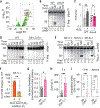Prophage terminase with tRNase activity sensitizes Salmonella enterica to oxidative stress
- PMID: 38574144
- PMCID: PMC11443816
- DOI: 10.1126/science.adl3222
Prophage terminase with tRNase activity sensitizes Salmonella enterica to oxidative stress
Abstract
Phage viruses shape the evolution and virulence of their bacterial hosts. The Salmonella enterica genome encodes several stress-inducible prophages. The Gifsy-1 prophage terminase protein, whose canonical function is to process phage DNA for packaging in the virus head, unexpectedly acts as a transfer ribonuclease (tRNase) under oxidative stress, cleaving the anticodon loop of tRNALeu. The ensuing RNA fragmentation compromises bacterial translation, intracellular survival, and recovery from oxidative stress in the vertebrate host. S. enterica adapts to this transfer RNA (tRNA) fragmentation by transcribing the RNA repair Rtc system. The counterintuitive translational arrest provided by tRNA cleavage may subvert prophage mobilization and give the host an opportunity for repair as a way of maintaining bacterial genome integrity and ultimately survival in animals.
Conflict of interest statement
Figures




References
Publication types
MeSH terms
Substances
Grants and funding
LinkOut - more resources
Full Text Sources
Molecular Biology Databases

